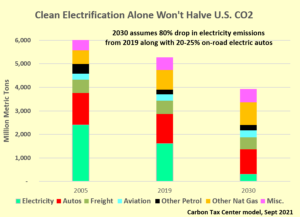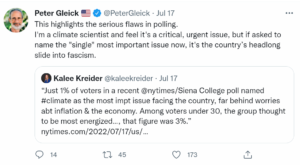A New York Times post this week, Biden’s Climate Change ‘Revolution’ Isn’t Coming, caught our attention with its trenchant look at climate policy’s low ebb in the wake of two crushing setbacks in just three weeks: the June 30 Supreme Court ruling blowing up EPA’s carbon-regulating authority under the Clean Air Act, and Joe Manchin’s coup de grace to the remnants of President Biden’s Build Back Better climate package.
Drawing on fellow Times writers, opinion editor Spencer Bokat-Lindell painted an unsparing portrait of U.S. — and global — climate stasis as dangerous heat was enveloping Britain, much of Europe and large swaths of the U.S. Here we reprint his post in full, with our commentary as counterpoint.
Biden’s Climate Change ‘Revolution’ Isn’t Coming.IntroductionWhen President Biden took office, one of the first things he did was make a pledge: The United States, he vowed, would finally “meet the urgent demands of the climate crisis” through “a clean energy revolution.” That revolution was to be set in motion by a $2 trillion plan for putting the country on a path to 100 percent carbon-free electricity by 2035 and to net-zero greenhouse gas emissions by 2050, in line with the Paris agreement’s goal of keeping global warming well below 3.6 degrees Fahrenheit above preindustrial levels. (It now stands at 2.2 degrees.) But after more than a year of negotiations, compromises, deal-making and belt-tightening, that plan appeared to collapse last week when Senator Joe Manchin, a conservative Democrat from West Virginia and a key swing vote in Congress, announced that he would not support funding for climate or energy programs. What does the collapse of Biden’s agenda mean for the domestic and global politics of climate action moving forward? Here’s what people are saying. |
Biden’s Plan, Though Not Revolutionary, Was Bold.Introduction
(Chart is from CTC Sept 2021 post, Without a Carbon Tax, Don’t Count on a 50% Emissions Cut.) |
1. The climate deal that wasn’tAs my colleagues have reported, experts generally agree that there are two ways of reducing greenhouse gas emissions at the speed and scale required. The first is making fossil fuels more expensive by ensuring that their environmental costs — global warming, for one, but also the staggering harms of air pollution — are reflected in their price. While widely championed by economists, carbon taxes have proved politically unpopular: A carbon tax by ballot referendum in Washington State has failed twice. Biden hoped to take the other approach: reducing emissions by driving down the cost and improving the efficiency of low-carbon energy sources, like wind, solar and nuclear power. Initially, the centerpiece of his plan was a clean energy standard, which would have legally required utilities to draw 80 percent of their electricity from zero-carbon sources by 2030 and 100 percent by 2035. But when Manchin — who made millions from his family coal business and took more campaign money from the oil and gas industry than any other senator — pulled his support from that scheme in October, Democrats pivoted to a $300 billion package of tax credits to encourage the adoption of renewable energy and electric vehicles. Now, both avenues to decarbonizing the country have been all but closed off. Even before Biden’s plan was whittled down, there was some debate about whether it was sufficient to meet his ambitions. But now that the president’s most powerful tools for reducing emissions have been confiscated by Congress (and the Supreme Court, which last month limited the power of the Environmental Protection Agency to regulate power plant emissions), “We are not going to meet our targets, period,” said Leah Stokes, a professor of environmental policy at the University of Santa Barbara, California, who has advised congressional Democrats on climate legislation. Manchin’s reason for scuttling the negotiations, according to his spokeswoman, was his desire to “avoid taking steps that add fuel to the inflation fire.” But in The Atlantic, Robinson Meyer argues that, in addition to being “extraordinarily bleak for the climate,” Manchin’s reversal will actually worsen inflation: By reducing long-term demand for oil, Biden’s plan would probably have lowered gas prices, and an earlier version of the package would have led to hundreds of dollars in annual energy cost savings for the average U.S. household by 2030, according to an independent analysis from researchers at Princeton. “America’s climate negligence endures,” Meyer writes. “That is not just due to Senator Manchin’s negligence, of course. It is also the collective responsibility of the Republican Party, whose 50 senators are even more resolutely against investing in clean energy than he is.” |
1. The long shadow of Washington state’s failed carbon tax referendumBokat-Lindell could have said, about carbon taxes, that they are widely championed by economists and others who judge robust carbon taxing as uniquely capable of delivering big emission cuts quickly. Still, his characterization of carbon taxes as politically unpopular was fair. He was also on solid ground in pointing to the failed Washington State carbon tax referendum. Perhaps even more than Donald Trump’s concurrent electoral win over Hillary Clinton, the 2016 defeat of Initiative 732 put a hurt on U.S. carbon tax organizing and advocacy. After all, if a carbon tax couldn’t garner an electoral majority in a certified blue state — one with a strong outdoors-nature ethic to boot — it was likely to be a tough sell almost anywhere else.
Fast-forwarding to 2021-2022, it’s also fair to ask why climate activists trained virtually all of their fire on Joe Manchin, perhaps not grasping that his personal and political indebtedness to fossil fuels — duly noted by Bokat-Lindell — placed him beyond their reach. As The Atlantic’s Robinson Meyer notes, 50 Republicans blocked Biden’s climate package no less than Manchin. Protests in their home states might have moved the legislative needle or at least thrown down a marker to preserve Democrats’ control of Congress in the coming midterms. |
2. A domestic defeat with global consequencesBecause the United States has spewed more greenhouse gases into the atmosphere than any other nation, it plays a uniquely prominent role in global climate politics. (It’s worth noting that on an annual basis, China is now the world’s largest emitter, having surpassed the United States in 2006, though America’s per capita emissions still far exceed China’s.) Given the United States’ historical “climate debt,” many lower-income countries have made their climate commitments contingent on those of the United States and other rich countries. Especially after Donald Trump withdrew from the Paris agreement, many world leaders were hopeful that Biden would arrive at the Glasgow climate talks last year having secured some legislative achievement as a mark of political seriousness. That, of course, did not happen. Now, the United States’ international climate credibility is even more damaged, which will in turn impede global decarbonization efforts, The Times’s Somini Sengupta writes. “Manchin’s rejection and the recent Supreme Court ruling dealt a heavy blow to U.S. climate credibility,” Li Shuo, the Beijing-based senior policy adviser for Greenpeace East Asia, told her. It underlines what many people abroad already know, Li said: that “the biggest historical emitter can hardly fulfill its climate promises.” The U.S. climate envoy, John Kerry, is expected to attend the next round of climate talks, in November in Egypt, but will once again have little to show for it. The United States “will find it very hard to lead the world if we can’t even take the first steps here at home,” said Nat Keohane, the president of the Center for Climate and Energy Solutions, an environmental group. “The honeymoon is over.” |
2. Goodbye to the myth of U.S. global leadership on climateWe noted upfront that in addition to their sheer numerical weight, Build Back Better’s carbon reductions would have triggered parallel policies in other countries. Bokat-Lindell articulates this well, with framing that, appropriately, prioritizes U.S. climate stewardship as “necessary” rather than merely “sufficient.” What would translate almost automatically from the domestic sphere to the global is U.S. federal-level carbon taxing. The simplicity of a national carbon price alone makes it child’s play to replicate it in any other country — in marked contrast to the welter of tax credits, rules and line items embodying Biden’s climate plan that would be devilishly hard if not downright impossible to copy elsewhere. Moreover, the logical companion piece to a national carbon tax — a Carbon Border Adjustment Mechanism — would powerfully incentivize non-carbon-taxing countries to enact their own in order to capture for themselves carbon tax levies that otherwise would be collected by their carbon-taxing trading partners. That said, the various stories and authorities cited in the Times column have it exactly right. The heavy weight of America’s outsize cumulative carbon emissions, combined with what now must be seen as chronic federal government inaction — aptly summarized by Greenpeace as (“the biggest historical emitter can hardly fulfill its climate promises”) — expose the U.S. as climate laggard rather than leader. Unfortunately, that fact didn’t keep U.S. Senator Lindsey Graham (R-SC), who once supported carbon pricing via cap-and-trade (see this 2009 op-ed in the New York Times), from uttering this arrant nonsense this week: “I don’t want to be lectured about what we need to do to destroy our economy in the name of climate change.” |
3. Where the politics of climate action go from hereThe Biden administration will have to rely on its less powerful arsenal of executive actions to make progress on its decarbonization efforts, however short of its initial targets. As The Times’s Coral Davenport explains, the White House could use its regulatory authority to increase vehicle emissions standards, potentially catalyzing the transition to electric vehicles; to compel electric utilities to slightly lower their greenhouse emissions without falling afoul of the Supreme Court; and to plug leaks of methane — an extremely potent greenhouse gas — from oil and gas wells. Biden may also use his pulpit to push for action at the state level, where climate policy has assumed new importance in the absence of federal leadership. “States are really critical to helping the country as a whole achieve our climate goals,” Kyle Clark-Sutton of the clean-energy think tank RMI told The Times. “They have a real opportunity to lead. They have been leading.” Both California and New York, for example, have committed to reaching net-zero emissions by no later than 2050. As far as national electoral politics are concerned, The Times’s David Leonhardt argues, the fact that a single Democratic politician was able to derail Biden’s climate agenda should prompt Democrats to redouble their efforts to increase their Senate majority, particularly by winning over more voters in red and purple states. “It is clear that many blue-collar voters don’t feel at home in the Democratic Party — and that their alienation is a major impediment to the U.S. doing more to slow climate change,” he writes. It is also possible that the government’s sclerosis could spur interest in less conventional and extra-electoral avenues to addressing climate change, among them nuclear power (the promise and drawbacks of which have been explored in this newsletter; the “degrowth” movement; speculative technological fixes such as solar geoengineering; and mass movements of civil and uncivil disobedience, as the ecologist Andreas Malm called for in his book How to Blow Up a Pipeline. As the Colorado River reservoirs dry up, as the death toll from the record-setting heat waves and wildfires scorching Europe rises, and as more than a billion people in South Asia recover from a season of heat extreme enough to test the upper limits of human survivability, “this moment feels interminable,” Meyer of The Atlantic writes. “But what is unsustainable cannot be sustained. If one man can block the industrial development of what is, for now, the world’s hegemon, then its hegemony must be very frail indeed.” But then, climate change seems to remain a relatively minor concern among the U.S. electorate: Just 1 percent of voters in a recent New York Times/Siena College poll named it as the most important issue facing the country; even among voters under 30, that figure was 3 percent. That is just one poll. But it would perhaps be premature to rule out another direction the politics of climate change might take, one that could prove familiar to those who have witnessed how the American public has processed other cumulative traumas, like the drug overdose crisis or gun violence or the pandemic: a resigned acceptance of mass suffering, punctuated by moments of shock that serve only as reminders of how the unimaginable became normal. |
3. The impasse at the abyssBokat-Lindell packed many leads and ideas into his closing section. We’ve touched on a lot of them in the past year. Our high points: A. The “arsenal” of potential executive actions is terribly meager vis-a-vis the task at hand. Stronger CAFE standards, for example, are badly undermined by light trucks’ takeover of the automotive fleet, and are assumed in most climate emission scenarios anyway. B. States-as-climate-loci is also overblown. A full two dozen are solidly red, i.e., fossil fuel dominated. Even in blue states, policy is circumscribed by federal authority and bureaucracy; the holdup of New York’s congestion pricing program by federal highway officials is one case in point. Moreover, visions of 2050 net-zero or 2035 grid decarbonization by California and New York are almost certainly way out in front of actual commitments and have been made needlessly more difficult by nuclear power plant shutdowns. C. Securing a true Democratic Senate majority and retaining the House this November are indeed vital.
E. The low primacy of the climate crisis among voters is both real and arguably not fatal. The U.S. is beset by so many crises that even so committed a climate scientist as Peter Gleick declared this week his greater alarm over incipient fascism. A greater cause than insufficient ardor of the U.S. failure to enact “revolutionary” or even strong, incremental climate policies is an unproportionate and cumbersome political system that puts up multiple roadblocks to systemic change. Alas, that isn’t poised to change. More and more, it looks like achieving genuine climate action will require passionate and creative direct action. Targets abound: helicopter commuting, crypto “mining,” obstructionists of wind farms or dense housing or congestion pricing, to name a few. Successful actions will be those that harness broad-based and truly intersectional campaigns attacking not just emissions but privilege and wealth. We have an idea or two up our sleeve. Perhaps you do as well. We wish you luck. We still insist that carbon taxing is revolutionary — how can tackling a fundament of fossil fuel dominance be otherwise? |

 Even a fully intact Biden plan would have fallen short of its goals. Nevertheless, its scope and reach would have far surpassed any climate program by any major nation. Build Back Better’s carbon reductions and climate benefits would have been numerically substantial and would also have triggered parallel policies in other countries.
Even a fully intact Biden plan would have fallen short of its goals. Nevertheless, its scope and reach would have far surpassed any climate program by any major nation. Build Back Better’s carbon reductions and climate benefits would have been numerically substantial and would also have triggered parallel policies in other countries. During the run-up to that vote we published
During the run-up to that vote we published  D. Like Andreas Malm, we believe that direct action in defense of climate and earth needs to come to the fore, as we proposed in two posts last summer inspired by Malm’s book: Christopher Ketcham’s essay,
D. Like Andreas Malm, we believe that direct action in defense of climate and earth needs to come to the fore, as we proposed in two posts last summer inspired by Malm’s book: Christopher Ketcham’s essay, 